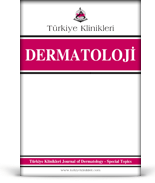Objective: Hidradenitis suppurativa (HS) is a chronic, recurrent inflammatory skin disease. Our aim of this study is to review the demographic, clinical characteristics, treatment options of the patients who were being followed up with diagnosis of HS in our hospital during the last 9 years and to make a comparison with the data from other countries. Material and Methods: A total of 59 patients with HS diagnosed in our Dermatology Department between 2010-2019 were evaluated retrospectively. Results: Seventeen (28.8%) of 59 patients were female, 42 (71.2%) were male. The mean age at diagnosis was 31.05±1.61 (minimum / maximum: 14-60). Seventeen patients (28.8%) had stage 1, 26 patients (44.1%) had stage 2 and 16 patients (27.1%) had stage 3 disease. Axilla was the most affected area. Topical agents (topical clindamycin, antiseptic solutions) and oral antibiotics (doxycycline, ciprof loxacin, ampicillin-sulbactam, amoxicillin-clavulanic acid) were the most commonly used treatment options. Treatment resistant eight patients were treated with a biological agent adalimumab. Conclusion: In literature, there are few epidemiological studies related to HS in Turkey. The clinical, demographic and therapeutic data of 59 HS cases in our clinic were summarized. However, we believe that multi-center studies conducted with larger number of patients are needed in order to reach more comprehensive data on this subject.
Keywords: Hidradenitis suppurativa; hidradenitis; disease management
Amaç: Hidradenitis süpürativa (HS) kronik, tekrarlayan inflamatuar bir cilt hastalığıdır. Bu çalışmada amacımız, son 9 yılda hastanemizde HS tanısı ile takip edilen hastaların demografik, klinik özellikleri, tercih edilen tedavi seçeneklerini gözden geçirmek ve diğer ülkelerdeki verilerle karşılaştırmaktır. Gereç ve Yöntemler: Çalışmamızda 2010-2019 yılları arasında Dermatoloji kliniğinde tanı koyulan 59 HS hastası retrospektif olarak değerlendirildi. Bulgular: Elli dokuz hastanın 17'si (%28,8) kadın, 42'si (%71,2) erkekti. Hastaların tanı sırasındaki yaş ortalaması 31,05±1,61 (minimum/ maksimum: 14-60) idi. Hastalardan 17'si (%28,8) evre 1,26'sı (%44,1) evre 2,16'sı (%27,1) evre 3 olarak değerlendirildi. Aksilla en fazla etkilenen bölgeydi. Topikal ajanlar (topikal klindamisin, antiseptik solüsyonlar) ve oral antibiyotikler (doksisiklin, siprofloksasin, ampisilin-sulbaktam, amoksisilin-klavulanik asit) en sık kullanılan tedavi seçenekleriydi. Tedaviye dirençli 8 hasta biyolojik ajanlardan adalimumab ile tedavi edildi. Sonuç: Literatürde, Türkiye'de HS ile ilgili yapılan az sayıda epidemiyolojik çalışma bulunmaktadır. Kliniğimizde takip edilen 59 HS vakasının klinik, demografik ve terapötik verileri özetlendi. Ancak, bu konuda daha kapsamlı verilere ulaşmak için çok merkezli ve daha fazla vaka içeren çalışmalara ihtiyaç olduğuna inanıyoruz.
Anahtar Kelimeler: Hidradenitis süpürativa; hidradenit; hastalık yönetimi
- Gönül M, Gül Ü. [Hidradenitis suppurativa]. Turkish Journal of Dermatology. 2009;3(1):9-12.
- Keskin M, Balık E. [Hidradenitis suppurativa]. Turkiye Klinikleri J Gen Surg-Special Topics. 2016;9(2):62-9.
- Calao M, Wilson JL, Spelman L, Billot L, Rubel D, Watts AD, et al. Hidradenitis suppurativa (HS) prevalence, demographics and management pathways in Australia: a population-based cross-sectional study. PLoS One. 2018;24:13(7):e0200683. [Crossref] [PubMed] [PMC]
- Wiseman MC. Hidradenitis suppurativa: a review. Dermatol Ther. 2004;17(1):50-4. [Crossref] [PubMed]
- Yu CC, Cook MG. Hidradenitis suppurativa: disease of follicular epithelium, rather than apocrine glands. Br J Dermatol. 1990;12(6):763-9. [Crossref] [PubMed]
- İşgör A. [Hidradenitis suppurativa]. ANKEM Derg. 2011;25(2):121-4. [Crossref]
- Seyed Jafari SM, Knüsel E, Cazzaniga S, Hunger RE. A retrospective cohort study on patients with hidradenitis suppurativa. Dermatology. 2018;234(1-2):71-8. [Crossref] [PubMed]
- Hurley HJ. Axillary hyperhidrosis, apocrine bromhidrosis, hidradenitis suppurativa and familial benign pemphigus: surgical approach. In: Roenigk RK, Roenigk HH, eds. Dermatologic Surgery. 1st ed. New York, NY: Marcel Dekker; 1989. p.729-39.
- Andrade TCPC, Vieira BC, Oliveira AMN, Martins TY, Santiago TM, Martelli ACC. Hidradenitis suppurativa: epidemiological study of cases diagnosed at a dermatological reference center in the city of Bauru, in the Brazilian southeast State of São Paulo, between 2005 and 2015. An Bras Dermatol. 2017;92(2):196-9. [Crossref] [PubMed] [PMC]
- Vankeviciute RA, Polozovaite B, Trapikas J, Raudonis T, Grigaitiene J, Bylaite-Bucinskiene M. A 12-year experience of hidradenitis suppurativa management. Adv Skin Wound Care. 2019;32(1):1-7. [Crossref] [PubMed]
- Ahmad Kamil MA, Mohd Affandi A. Hidradenitis suppurativa in Kuala Lumpur, Malaysia: a 7-year retrospective review. Dermatol Res Pract. 2018;2018:2017959. [Crossref] [PubMed] [PMC]
- Choi E, Chandran NS. Management of hidradenitis suppurativa: experience from a Singaporean dermatologic institute. Hong Kong J Dermatol Venereol. 2018;26(1):5-9.
- Bilgen F, Ural A, Bekerecioğlu M. [Surgical treatment success in hidradenitis suppurativa: deep and wide surgical excision]. KSU Medical Journal. 2018;13(1):13-8.
- Egemen O, Özkaya Ö, Orman Ç, Kayadibi T, Akan M. [Our approach to patients with Hidradenitis suppurativa and evulation of outcomes]. Turk Plast Surg. 2013;21(3):11-6.
- von der Werth JM, Williams HC. The natural history of hidradenitis suppurativa. J Eur Acad Dermatol Venereol. 2000;14(5):389-92. [Crossref] [PubMed]
- Temel B, Adışen E, Gürer MA. [Hidradenitis suppurativa: update]. Dermatoz. 2018;9(2):1-20.
- Engin B, Özkoca D, Kutlubay Z, Serdaroğlu S. Metabolic syndrome in dermatology: treatment and management for dermatologists. Dermatol Ther. 2019;32(2):e12812. [Crossref] [PubMed]
- Egeberg A, Gislason GH, Hansen PR. Risk of major adverse cardiovascular events and all-cause mortality in patients with hidradenitis suppurativa. JAMA Dermatol. 2016;152(4): 429-34. [Crossref] [PubMed]
- Shavit E, Dreiher J, Freud T, Halevy S, Vinker S, Cohen AD. Psychiatric comorbidities in 3207 patients with hidradenitis suppurativa. J Eur Acad Dermatol Venereol. 2015;29(2):371-6. [Crossref] [PubMed]
- Andersen RK, Jemec GB. Treatments for hidradenitis suppurativa. Clin Dermatol. 2017;35(2):218-24. [Crossref] [PubMed]
- Crowley EL, O'Toole A, Gooderham MJ. Hidradenitis suppurativa with SAPHO syndrome maintained effectively with adalimumab, methotrexate, and intralesional corticosteroid injections. SAGE Open Med Case Rep. 2018;6:1-3. [Crossref] [PubMed] [PMC]
- Yazdanyar S, Boer J, Ingvarsson G, Szepietowski JC, Jemec GB. Dapsone therapy for hidradenitis suppurativa: a series of 24 patients. Dermatology. 2011;222(4):342-6. [Crossref] [PubMed]
- Jemec GBE, Okun MM, Forman SB, Gulliver WPF, Prens EP, Mrowietz U, et al. Adalimumab medium-term dosing strategy in moderate-to-severe hidradenitis suppurativa: integrated results from the phase 3, randomized, placebo-controlled, PIONEER trials. Br J Dermatol. 2019 Mar 27. Doi: 10.1111/ bjd.17919. [Epub ahead of print]. [Crossref] [PubMed]







.: Process List